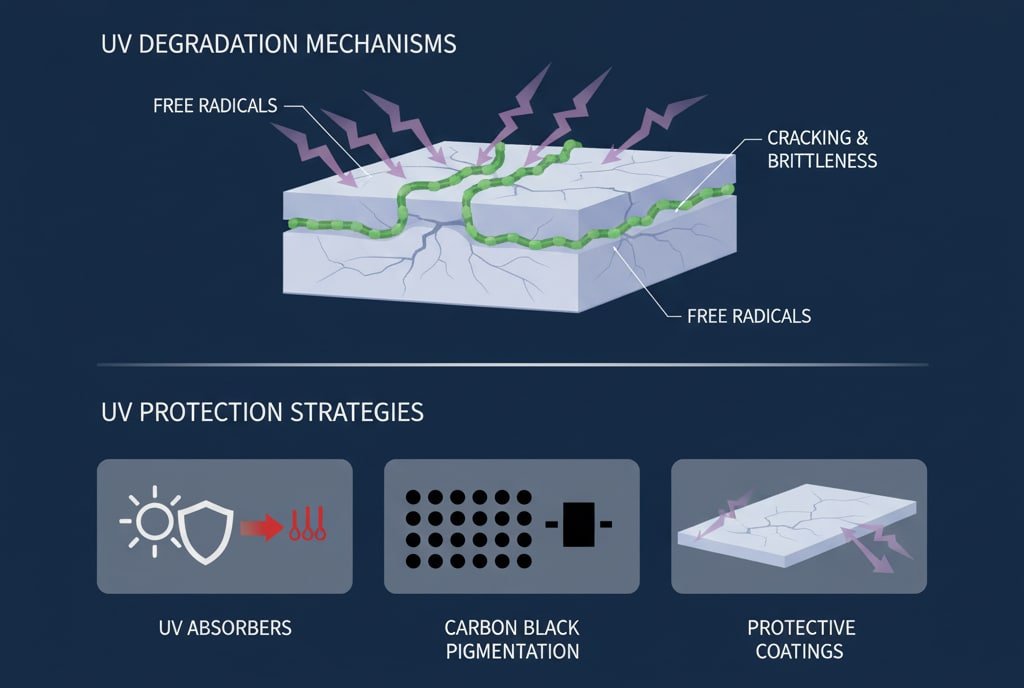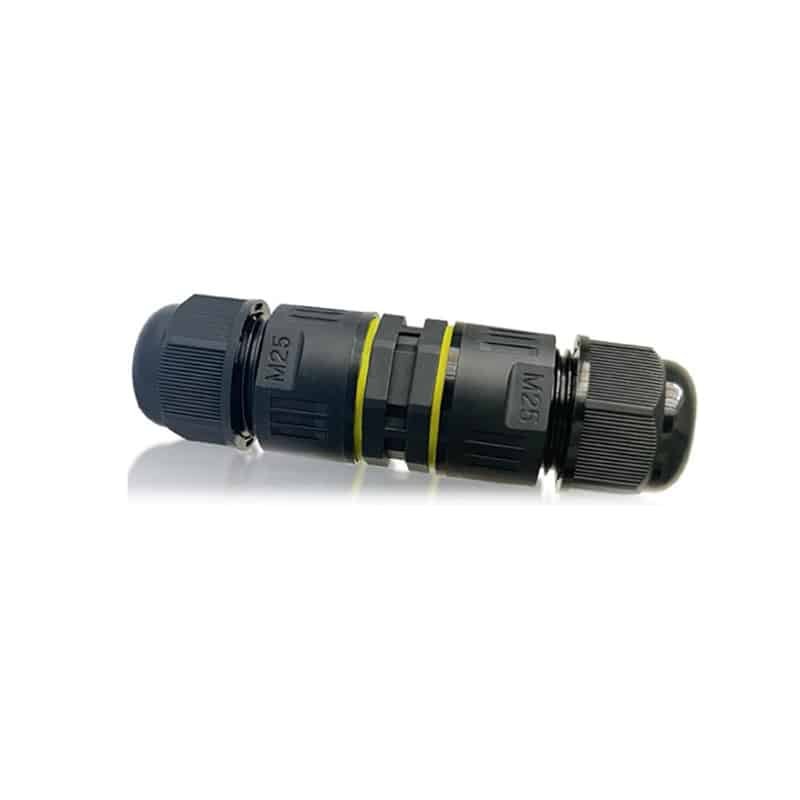UV radiation destroys 70% of outdoor electrical connectors within 5 years1, causing brittle housings, seal failures, and catastrophic system downtime that costs thousands in repairs and replacements. Standard plastic materials crack, fade, and lose mechanical properties when exposed to intense sunlight, creating safety hazards and reliability issues in critical outdoor applications. Materiali, odporni na UV žarke, za zunanje vodotesne konektorje vključujejo UV stabiliziran najlon z dodatki ogljikovih saj, nerjavno jeklo za plovila z ustrezno površinsko obdelavo, specializirane elastomere, kot sta EPDM in silikon, ter napredne polimerne spojine z vgrajenimi UV absorberji, pri čemer ima vsak posebne prednosti za različne okoljske pogoje in zahteve uporabe. After a decade of solving UV degradation problems at Bepto, I’ve learned that material selection isn’t just about initial UV resistance – it’s about understanding how different materials age under real-world conditions and choosing solutions that maintain performance throughout their service life.
Kazalo vsebine
- What Makes Materials UV-Resistant for Outdoor Applications?
- Which Plastic Materials Offer the Best UV Protection?
- How Do Metal Materials Compare for UV Resistance?
- What Are the Best Elastomer Options for UV Environments?
- How Do You Select Materials for Specific UV Exposure Conditions?
- FAQs About UV-Resistant Materials
What Makes Materials UV-Resistant for Outdoor Applications?
Understanding UV resistance mechanisms helps engineers select appropriate materials for long-term outdoor performance. Materials become UV-resistant through carbon black pigmentation that absorbs UV energy, chemical UV stabilizers that prevent polymer chain degradation, surface treatments that reflect UV radiation, molecular structure modifications that resist photodegradation, and protective coatings that shield base materials from direct UV exposure.

Mehanizmi razgradnje zaradi UV sevanja
Razcep polimerne verige2: UV photons break chemical bonds in polymer chains, reducing molecular weight and causing brittleness, cracking, and mechanical failure.
Nastajanje prostih radikalov: UV energy creates reactive free radicals that propagate damage throughout the material structure, accelerating degradation processes.
Cross-Linking Effects: Some materials form excessive cross-links under UV exposure, becoming hard and brittle rather than maintaining flexibility.
Surface Chalking: UV degradation creates powdery surface residue that indicates advanced material breakdown and loss of protective properties.
Strategije zaščite
Absorberji UV-žarkov: Chemical compounds like benzotriazoles and benzophenones absorb UV energy and convert it to harmless heat rather than allowing polymer damage.
Stabilizatorji svetlobe z vsebnostjo aminov (HALS)3: These compounds neutralize free radicals formed during UV exposure, preventing propagation of degradation reactions.
Ogljikova črnina Nalaganje: Fine carbon black particles absorb UV radiation across the entire spectrum, providing excellent protection for black materials.
Titanium Dioxide Pigmentation: TiO2 reflects UV radiation and provides protection for light-colored materials while maintaining aesthetic appearance.
Robert, a solar farm maintenance manager in Arizona, USA, struggled with repeated cable gland failures after just 18 months of desert sun exposure. Standard nylon glands became brittle and cracked, causing water ingress during monsoon seasons that damaged expensive inverter equipment. We recommended our UV-stabilized nylon cable glands with 2% carbon black loading and HALS additives, specifically designed for extreme UV environments. The solution provided 5+ years of reliable service in 120°F temperatures and intense UV conditions, eliminating inverter failures and reducing maintenance costs by 80%.
Which Plastic Materials Offer the Best UV Protection?
Plastic material selection critically impacts long-term performance in outdoor waterproof connector applications. The best UV-resistant plastic materials include UV-stabilized PA66 nylon with carbon black additives for mechanical strength, polycarbonate with UV coatings for optical clarity, PBT polyester with glass reinforcement for dimensional stability, modified PPO for high-temperature applications, and specialized UV-grade polymers like ASA and PMMA for extreme exposure conditions.
Nylon (Polyamide) Variants
PA66 with UV Stabilizers: Excellent mechanical properties, chemical resistance, and flame retardancy make this ideal for cable gland housings and threaded components.
Glass-Filled Grades: 30% glass reinforcement improves dimensional stability and reduces thermal expansion while maintaining UV resistance.
Ogljikova črnina Nalaganje: 2-3% carbon black provides superior UV protection while maintaining processability and mechanical properties.
Flame Retardant Versions: UL94 V-0 rated materials4 meet safety requirements for electrical applications without compromising UV resistance.
Advanced Engineering Plastics
| Material | UV Rating | Temperaturno območje | Glavne prednosti | Tipične aplikacije |
|---|---|---|---|---|
| UV-PA66 | Odlično | -40 °C do +120 °C | High strength, chemical resistant | Cable gland bodies |
| PC-UV | Zelo dobro | -40 °C do +130 °C | Optical clarity, impact resistant | Transparent housings |
| PBT-GF30 | Dobro | -40°C to +140°C | Dimensional stability, low moisture | Precision components |
| Modificirani PPO | Odlično | -40 °C do +150 °C | High temperature, low expansion | Harsh environment |
| ASA | Odlično | -30 °C do +80 °C | Weather resistance, color stability | Aesthetic applications |
Processing and Additives
Stabilizer Packages: Combination UV absorbers and HALS provide synergistic protection better than individual additives alone.
Processing Aids: Proper processing temperatures and residence times prevent degradation during manufacturing that could compromise UV resistance.
Colorant Selection: Organic pigments may reduce UV resistance, while inorganic pigments like iron oxides provide additional protection.
Površinske obdelave: Post-molding UV coatings can enhance protection for critical applications requiring maximum longevity.
How Do Metal Materials Compare for UV Resistance?
Metal materials offer inherent UV resistance but require proper selection and treatment for optimal outdoor performance. Metal materials for UV resistance include marine-grade 316L stainless steel with electropolished finish, brass with nickel plating for corrosion protection, aluminum alloys with anodized coatings, zinc alloys with chromate conversion, and specialized coatings like PVD or powder coating for enhanced durability and aesthetic requirements.
Možnosti iz nerjavečega jekla
316L Marine Grade: Superior corrosion resistance in coastal environments with excellent UV stability and mechanical properties throughout temperature ranges.
Površinske obdelave: Electropolished surfaces reduce contamination adhesion and improve cleanability while maintaining corrosion resistance.
Passivation Treatments: Proper passivation removes free iron and enhances the protective oxide layer for long-term performance.
Welding Considerations: TIG welding with proper shielding gas maintains corrosion resistance in welded assemblies.
Protective Coatings
Powder Coating Systems: Polyester and polyurethane powder coatings provide color options while enhancing UV and corrosion protection.
PVD Coatings: Physical vapor deposition creates thin, durable coatings with excellent adhesion and wear resistance.
Anodizing Processes: Hard anodizing on aluminum provides excellent wear and corrosion resistance with good UV stability.
Plating Options: Nickel, chrome, and zinc plating systems offer different levels of protection and aesthetic appearance.
Analiza stroškov in učinkovitosti
Začetni stroški v primerjavi z življenjskim ciklom: Stainless steel has higher initial cost but lower total cost of ownership due to minimal maintenance requirements.
Ujemanje aplikacij: Match material grade to environmental severity – 304SS for mild conditions, 316L for marine/chemical environments.
Fabrication Considerations: Material selection affects machining, welding, and assembly processes that impact total manufacturing cost.
Zahteve za vzdrževanje: Proper material selection minimizes cleaning and maintenance requirements throughout service life.
Hassan, a petrochemical facility manager in Kuwait, required explosion-proof cable glands for outdoor process equipment exposed to extreme UV, temperatures up to 60°C, and corrosive chemical vapors. Standard brass glands corroded rapidly despite protective coatings, causing safety concerns and frequent replacements. We supplied our Certifikat ATEX5 316L stainless steel cable glands with electropolished finish and Viton seals. The solution provided 7+ years of maintenance-free service in the harsh Middle Eastern environment, ensuring safety compliance and eliminating unplanned downtime worth $50,000 per incident.
What Are the Best Elastomer Options for UV Environments?
Elastomer selection for seals and gaskets critically affects long-term waterproof performance in UV environments. The best elastomer options for UV environments include EPDM rubber with excellent ozone resistance, silicone elastomers for extreme temperature ranges, fluoroelastomers (Viton) for chemical compatibility, chloroprene (Neoprene) for general outdoor use, and specialized UV-grade compounds with enhanced stabilizer packages for maximum longevity.
EPDM Rubber Advantages
Odpornost na ozon: EPDM’s saturated polymer backbone resists ozone cracking that destroys other rubber materials in outdoor applications.
Temperaturno območje: Maintains flexibility from -50°C to +150°C, covering most outdoor application requirements with consistent sealing force.
Odpornost na vremenske vplive: Excellent resistance to UV, ozone, and weathering makes EPDM ideal for long-term outdoor sealing applications.
Stroškovna učinkovitost: Lower cost than specialty elastomers while providing excellent performance for most outdoor waterproof applications.
Lastnosti silikonskega elastomera
Temperaturni ekstremi: Maintains elasticity from -60°C to +200°C, ideal for applications with wide temperature variations.
UV stabilnost: Inorganic siloxane backbone provides inherent UV resistance without requiring additional stabilizers or fillers.
Kemična inertnost: Low reactivity with most chemicals and excellent biocompatibility for food-grade and medical applications.
Komplet za stiskanje: Moderate compression set resistance requires proper groove design for long-term sealing effectiveness.
Fluoroelastomer Performance
Kemijska odpornost: Outstanding resistance to oils, fuels, acids, and solvents makes Viton ideal for chemical processing environments.
Temperature Capability: Maintains properties from -20°C to +200°C with excellent thermal stability and aging resistance.
Odpornost na UV-žarke: Fluorinated backbone provides excellent UV stability, though carbon black loading improves performance further.
Upoštevanje stroškov: Higher material cost justified by superior performance and longevity in demanding applications.
How Do You Select Materials for Specific UV Exposure Conditions?
Material selection requires systematic evaluation of environmental conditions, performance requirements, and cost constraints. Material selection for specific UV exposure conditions involves assessing UV intensity levels, temperature cycling ranges, chemical exposure risks, mechanical stress requirements, regulatory compliance needs, maintenance accessibility, and total cost of ownership to match material properties with actual application demands.
Okoljska presoja
UV Intensity Mapping: Consider geographic location, altitude, and seasonal variations that affect UV exposure levels throughout the year.
Temperaturno kolesarjenje: Evaluate daily and seasonal temperature ranges that create thermal stress in addition to UV degradation.
Chemical Environment: Assess exposure to cleaning chemicals, industrial processes, or atmospheric pollutants that accelerate material degradation.
Mechanical Stresses: Consider vibration, thermal expansion, and installation stresses that interact with UV degradation mechanisms.
Zahteve za delovanje
Pričakovana življenjska doba: Define minimum acceptable service life to guide material selection and cost-benefit analysis.
Posledice neuspeha: High-consequence applications justify premium materials, while routine maintenance applications may use standard grades.
Estetske zahteve: Color stability and surface appearance may drive material selection for visible applications.
Skladnost s predpisi: Safety certifications (UL, ATEX, IP ratings) limit material options and require specific testing verification.
Selection Matrix
| UV Exposure Level | Priporočeni materiali | Pričakovana življenjska doba | Stroškovni dejavnik |
|---|---|---|---|
| Mild (Indoor/Shade) | Standard Nylon, Basic Elastomers | 10 let in več | 1.0x |
| Moderate (Partial Sun) | UV-Stabilized Plastics, EPDM | 7-10 let | 1.5x |
| Severe (Direct Sun) | Carbon Black Loaded, Stainless Steel | 5-7 let | 2.0x |
| Extreme (Desert/High Altitude) | Premium UV Grades, Metal Housing | 3-5 let | 3.0x |
Testiranje in potrjevanje
Pospešeno testiranje: Use QUV or xenon arc testing to predict long-term performance in compressed timeframes.
Testiranje na terenu: Deploy samples in actual application environments to validate laboratory predictions.
Analiza napak: Examine failed components to understand degradation mechanisms and improve material selection.
Spremljanje učinkovitosti: Track field performance to optimize replacement intervals and material specifications.
Zaključek
Selecting appropriate UV-resistant materials for outdoor waterproof connectors requires understanding degradation mechanisms, material properties, and application-specific requirements to achieve optimal performance and cost-effectiveness. By matching material capabilities to environmental conditions and performance expectations, engineers can design reliable systems that maintain waterproof integrity throughout their service life. At Bepto, our extensive experience with UV-resistant materials and real-world testing helps customers choose the right solutions for their specific applications – we’re here to help you navigate these complex decisions for long-term success 😉
FAQs About UV-Resistant Materials
Q: How long do UV-resistant materials last in outdoor applications?
A: UV-resistant materials typically last 5-10 years in direct sunlight depending on material type and environmental conditions. Premium grades with carbon black loading can achieve 7-10 years, while standard UV-stabilized materials provide 3-5 years of reliable service.
Q: What’s the difference between UV-stabilized and carbon black materials?
A: UV stabilizers are chemical additives that absorb or neutralize UV energy, while carbon black physically blocks UV radiation. Carbon black provides superior long-term protection but limits color options to black, while UV stabilizers allow various colors with moderate protection.
Q: Can I use indoor-rated materials for covered outdoor applications?
A: Indoor materials may work under full coverage but still face temperature cycling, humidity, and reflected UV exposure. UV-stabilized materials provide better long-term reliability even in covered applications, especially where occasional direct sunlight exposure occurs.
Q: How do I test UV resistance before full deployment?
A: Use accelerated UV testing (ASTM G154 or ISO 4892) to simulate years of exposure in weeks, or deploy samples in your actual environment for 6-12 months to evaluate real-world performance before large-scale installation.
Q: Are metal connectors always better than plastic for UV resistance?
A: Metal housings offer superior UV resistance but cost more and may require additional corrosion protection. High-quality UV-stabilized plastics can match metal performance at lower cost for many applications, making material selection dependent on specific requirements and budget constraints.
-
Review technical papers and reliability studies on the long-term effects of ultraviolet radiation on polymers used in outdoor electrical applications. ↩
-
Explore the chemical process of photodegradation, where UV photons break the molecular bonds in a polymer’s backbone, leading to material failure. ↩
-
Learn about the chemical mechanism of HALS, a class of additives that inhibit polymer degradation by scavenging free radicals generated by UV exposure. ↩
-
Understand the Underwriters Laboratories (UL) 94 standard, which classifies the flammability and fire safety of plastic materials. ↩
-
Spoznajte zahteve direktiv ATEX, standardov Evropske unije za opremo, namenjeno uporabi v potencialno eksplozivnih atmosferah. ↩



